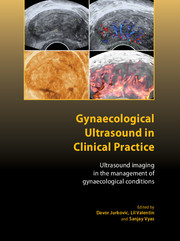 Gynaecological Ultrasound in Clinical Practice
Gynaecological Ultrasound in Clinical Practice Published online by Cambridge University Press: 05 February 2014
Introduction
One in six couples seeks help for infertility during their reproductive years. Subfertility investigations should be performed without delays (because female fertility decreases with age) and should be as noninvasive as possible. Many fertility clinics use diagnostic hysteroscopy to assess the uterine cavity and evaluate the tubal ostia. Laparoscopy is also often used to examine internal pelvic organs and to assess tubal patency. However, both hysteroscopy and laparoscopy are invasive and expensive tests which could be replaced by transvaginal ultrasound examination. Simplified ultrasound-based infertility investigation protocols have been described. The concept of a ‘pivotal’ pelvic ultrasound examination includes an examination of the uterus and uterine cavity, endometrium, ovarian morphology and follicular size, blood flow in the uterus and ovaries and hystero-contrast sonography (HyCoSy) to check tubal patency, all performed at the same examination. The late preovulatory phase of the menstrual cycle (days 8–12) is usually suggested as the optimal time to perform these examinations. Most studies involving the ultrasound techniques referred to in this chapter are classified as evidence grade B.
The pivotal scan
The aim of the pivotal scan is to assess the uterus, endometrium, fallopian tubes and ovaries.
Uterus
Ultrasound examination is as effective a diagnostic test as hysteroscopy or laparoscopy for the diagnosis of uterine abnormalities. Normal findings at ultrasound examination of the uterus and endometrium are described in Chapter 2. Uterine size and shape may be affected by ade-nomyosis or fibroids. The shape of the uterus can be also be distorted by congenital uterine anomalies.
To save this book to your Kindle, first ensure [email protected] is added to your Approved Personal Document E-mail List under your Personal Document Settings on the Manage Your Content and Devices page of your Amazon account. Then enter the ‘name’ part of your Kindle email address below. Find out more about saving to your Kindle.
Note you can select to save to either the @free.kindle.com or @kindle.com variations. ‘@free.kindle.com’ emails are free but can only be saved to your device when it is connected to wi-fi. ‘@kindle.com’ emails can be delivered even when you are not connected to wi-fi, but note that service fees apply.
Find out more about the Kindle Personal Document Service.
To save content items to your account, please confirm that you agree to abide by our usage policies. If this is the first time you use this feature, you will be asked to authorise Cambridge Core to connect with your account. Find out more about saving content to Dropbox.
To save content items to your account, please confirm that you agree to abide by our usage policies. If this is the first time you use this feature, you will be asked to authorise Cambridge Core to connect with your account. Find out more about saving content to Google Drive.